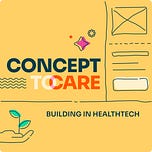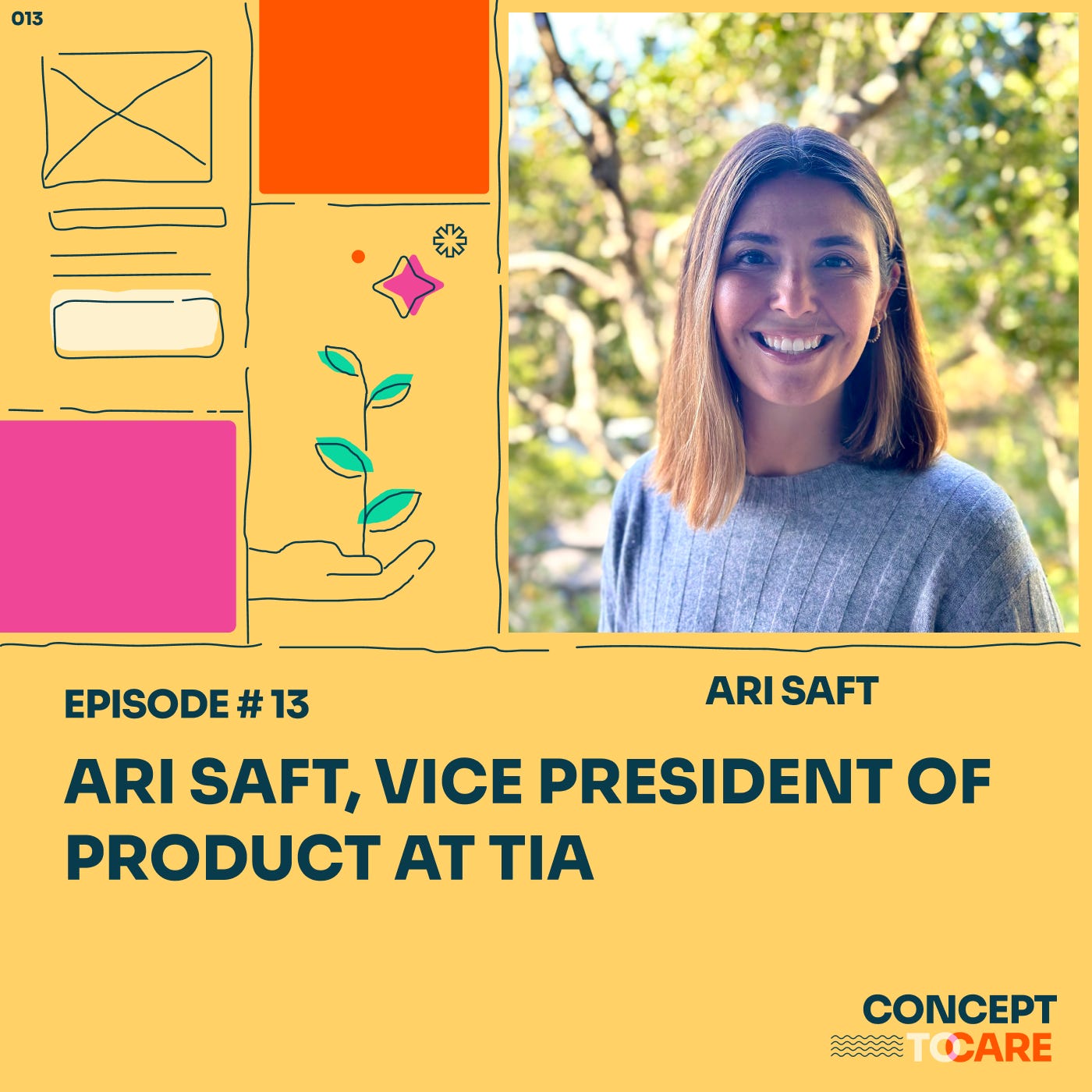Ari Saft is the Vice President of Product at Tia, where she leads the development of technology solutions that integrate virtual and in-person care for women’s health. With nearly five years at Tia, Ari has played a pivotal role in transforming the company’s product strategy to support its rapid growth from a single clinic to a multi-location operation. She brings a wealth of expertise in aligning product and operations, focusing on creating seamless healthcare experiences that prioritize both patient and provider needs. In our conversation, Ari shares her insights on:
Tia's Business Model and Vision: Ari discusses Tia’s evolution from a single clinic to a scalable, multi-location healthcare provider and how their mission to deliver high-quality, patient-centered care guides their product development.
The Challenges Behind the Product and Operations Relationship: Insights into the common friction points between product and operations teams as Tia scales and how to recognize the signs of a strained relationship.
Moving Towards a Productive Relationship Together: Practical strategies for aligning product and operations, rebuilding trust, and fostering collaboration to drive better outcomes for both teams.
Organizational Design and Culture: Ari's approach to structuring cross-functional teams and creating a culture that supports innovation, transparency, and continuous improvement at Tia.
Operational Hurdles with Moving from Custom-Built EMR to a Headless One: The decision to transition from a custom-built EMR to MedPlum, the challenges faced during this change, and how Tia managed the move to ensure agility and focus on their core value.
Tia's Future: Ari shares her vision for the future of Tia, including plans to expand their reach, refine their product offerings, and continue innovating to meet the evolving needs of women’s health.
In this episode of Concept to Care, Ari provides a deep dive into the challenges and successes of integrating product and operations in a rapidly growing healthcare company. Her insights on fostering collaboration, building scalable processes, and making data-driven decisions are invaluable for any product leader navigating the complexities of healthcare innovation.
Some takeaways:
Evolving Relationship Between Product and Operations with Scale: As Tia scaled from a single clinic to a multi-location operation, the relationship between product and operations had to evolve from product-driven innovation to a focus on operational consistency. Ari shared some of Tia’s structured approaches to managing this shift:
Cross-Functional Teams: Tia formed "tiger teams" with representatives from product, operations, and frontline staff to ensure all perspectives are integrated during decision-making and project execution.
Embedding Operations into Product Development: By embedding roles like "clinical product" directly into the product lifecycle, Tia ensures that operational needs are prioritized from the earliest stages of development.
Iterative Rollouts: Tia uses an iterative rollout process to gradually introduce new tools, incorporating feedback at each step to minimize disruptions to frontline operations.
Safe-to-Try Culture: Creating a "safe-to-try" environment encourages open dialogue about risks, allowing the team to address concerns collaboratively and build trust between product and operations.
These structured approaches help Tia align innovation with the realities of delivering scalable, high-quality care, balancing the needs of both product development and operational efficiency.
Recognizing a Strained Relationship with Operations - Red Flags for Product Teams: Ari discussed the telltale signs that product teams should watch for to identify when their relationship with operations is becoming strained:
Misalignment on Priorities: If operations frequently pushes back on product initiatives or feels that their needs are not being prioritized, it’s a sign that the two teams are not on the same page.
Lack of Early Involvement: When operations isn’t included early in the product development process, it can lead to friction later on. If product teams notice that operations teams are blindsided by new rollouts, it's a clear indicator of a disconnect.
Recurring Feedback Gaps: A strained relationship often manifests in feedback gaps, where operations feels that their input is either ignored or not incorporated into the product decisions, leading to frustration and disengagement.
Tool Frustration: If operations teams are consistently unhappy with the tools and systems introduced by product, citing them as disruptive rather than helpful, this indicates that product solutions are not aligned with operational needs.
Communication Breakdowns: When communication between product and operations becomes reactive rather than proactive, with both sides working in silos, it’s a strong signal that the collaborative dynamic needs improvement.
Expectation Gaps in Product and Operations Collaboration: Ari emphasized the importance of recognizing "expectation gaps" early on between product and operations teams. She explained that these gaps occur when there is a misalignment in what each side expects from the other, often resulting in misunderstandings and friction. As Ari put it, it's about realizing when you’re "having different expectation gaps" and working to "align on what each other's expectations are and meet in the middle." When product and operations don't clearly communicate their needs and goals upfront, both teams may end up working towards different outcomes, which leads to reactive problem-solving instead of proactive collaboration. Closing these gaps requires open dialogue, a willingness to understand each other's perspectives, and finding a shared path forward that aligns with both teams' objectives.
Remedying the Product-Operations Relationship: Ari suggested several strategies for repairing a strained relationship between product and operations:
Early Involvement and Open Dialogue: Ari stressed the importance of involving the operations team early in the product development process, starting from the discovery and design phases. This ensures that their insights and concerns are considered before any major decisions are made.
Cross-Functional Syncs: Regular cross-functional meetings, where team members are encouraged to bring problems (not just solutions), help both teams collaborate on finding the best path forward. This approach shifts the focus from individual team goals to shared problem-solving.
Building Trust through Radical Candor: Ari recommended using a candid and honest communication style to build trust between teams. By being open about challenges and potential issues, both product and operations teams can create a more transparent and supportive working environment.
Super User Groups: Tia leverages super user groups to gather real-time feedback from frontline staff and operations. These groups provide insights into what works and what doesn’t, allowing the product team to make iterative adjustments based on direct input from end-users.
Balancing Innovation with Operational Realities: Ari highlighted the need for product teams to balance their innovative ambitions with the practical needs of the operations team, ensuring that new tools and features do not disrupt workflows but instead enhance the team's efficiency.
Structuring Cross-Functional Teams for Success: Ari shared her approach to structuring cross-functional teams to ensure effective collaboration between product and operations:
Dual Organizational Focus: At Tia, the organization is split into two main groups: the innovation team (product, engineering, growth, and marketing) and the clinical and operational team (markets, real estate, and core operations). This clear division helps align focus areas and expertise.
Embedded Roles: Ari highlighted the role of embedded positions like "clinical product" and "product enablement," which act as liaisons between the innovation and clinical teams. These roles attend product meetings, grooming sessions, and design syncs to ensure that both sides remain connected and aligned on goals.
Product Enablement Team: Tia has a dedicated product enablement team that works closely with the operations side to identify gaps and optimize processes before they are fully productized. This approach allows the team to validate ideas and requirements with operational input before building solutions.
Cross-Functional Rituals: Regular cross-functional rituals like grooming sessions and design syncs include representatives from both product and operations, ensuring that each team is aware of ongoing projects and can provide input early in the process. This level of involvement helps mitigate misunderstandings and ensures that projects address real-world needs.
Documentation as a Key to Scalability and Alignment: Ari highlighted the importance of robust documentation in supporting Tia’s rapid product evolution and cross-team alignment. By centralizing knowledge using tools like Guru, Tia ensures that operations and frontline staff have quick access to up-to-date information, reducing knowledge gaps and enhancing onboarding. Effective documentation also strengthens feedback loops, enabling continuous improvement and smoother scaling of innovations across the organization.
Using Metrics to Drive Alignment and Accountability: Ari shared a simple but effective approach for using metrics to keep product and operations teams aligned. Here are the key steps she recommended:
Define a “North Star” Metric: Start with a clear metric that reflects your company’s mission—like patient retention or engagement—and use it to guide decisions across both product and operations teams.
Combine Quantitative and Qualitative Data: Use a mix of:
Quantitative data: such as care plan adherence, appointment follow-up rates, and other measurable outcomes.
Qualitative feedback: like patient satisfaction scores and direct user feedback to gain insights into areas for improvement.
Regularly Review Metrics in Cross-Functional Meetings: Schedule frequent reviews of these metrics with both product and operations teams to ensure everyone stays aligned on goals and priorities.
Tie Metrics to Measurable Outcomes: Make sure every product update or new feature is directly linked to these metrics to keep your teams focused on driving real, measurable impact.
Transitioning from a Custom EMR to MedPlum: Boosting Agility and Focus: Ari discussed Tia’s move from a custom-built EMR to MedPlum, highlighting several key aspects:
Why Tia Switched: The custom EMR became a constraint as Tia scaled, requiring too much maintenance and limiting their agility. Switching to MedPlum allowed Tia to focus on their core strengths—delivering superior care—without the burden of managing backend infrastructure.
Benefits Gained: MedPlum's headless architecture enabled faster iterations and more customized interfaces, giving Tia the flexibility to adapt quickly to patient and provider needs.
Change Management: Tia executed a phased rollout with clear communication and continuous feedback, ensuring a smooth transition and minimizing disruption to clinical teams.
Key Learnings: The experience underscored the importance of focusing on core competencies and investing in scalable solutions that grow with the company, rather than becoming bottlenecks.
Structured Roadmapping and Execution: Ari explained Tia's roadmapping approach, which emphasizes an impact-versus-effort analysis to prioritize high-value projects. Here’s how they execute this process:
Quarterly Planning Framework: Tia sets clear goals each quarter, using an impact-versus-effort analysis to prioritize projects that offer the most value for the least effort.
Impact over Effort Prioritization: Product, engineering, operations, and clinical teams work together to rank initiatives by their potential impact versus required effort, ensuring a focus on the highest-value projects.
Regular Check-Ins: The team reviews progress regularly, adjusting priorities based on impact-versus-effort evaluations to stay agile and responsive.
Transparent Execution: Roadmaps and updates are shared openly to keep all teams aligned, enabling quick pivots and reinforcing focus on impactful projects.
For a deeper dive into the conversation with Ari Saft, listen to the full episode and learn more about how Tia is revolutionizing women's healthcare through innovative product development and cross-functional collaboration.
—
Where to find Ari Saft:
LinkedIn: https://www.linkedin.com/in/ari-saft/
email: ari.w.saft@gmail.com
Tia: https://asktia.com/
—
Where to find Angela and Omar:
Angela Suthrave
Omar Mousa
—
Referenced:
Tia: https://asktia.com/
Tia Discount: $50 off your annual membership when you use promo code “ari445” Become a Tia member here
Ari’s favorite prioritization framework, impact over effort: https://blog.logrocket.com/product-management/impact-effort-matrix-prioritization/
Medplum: https://www.medplum.com/
Explanation on “headless” architecture: https://alokai.com/blog/headless-architecture
Guru: https://www.getguru.com/
Ari’s favorite tools:
ChatGPT: https://openai.com/
Loom: https://www.loom.com/
FigJam: https://www.figma.com/figjam/
Confluence: https://www.atlassian.com/software/confluence
Quarterly OKR planning: https://www.leapsome.com/blog/okr-planning
Effective usage of tiger teams: https://www.lucidchart.com/blog/what-is-a-tiger-team
Safe-to-try mindset: https://kb.founderculture.net/public/posts/0uuqt9dd
—
Check out our website: https://www.concepttocare.com
Follow us and Subscribe wherever you get your podcast:















Share this post